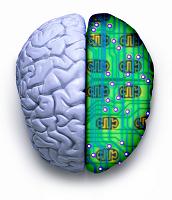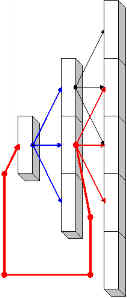
Architecture
Chapter 1, The Basics
 |
Architecture Chapter 1, The Basics |
The basic premise of this neural research is the replication of individual events to act as individual neurons, and then setting these events into pathways that can replicate the pathways of the brain. By studying the results of trial stimulation, we can gain insight into how our biological counterparts function and maybe discover along the way the meaning of consciousness. Please note that this is not an attempt to reverse engineer the human brain to the infinite degree like the Blue Brain project that is being conducted by IBM. This is an attempt to get brain like qualities using the same basic concepts based on the mammalian brain. I call this the Volkswagen approach.
The Individual Neuron
The individual neuron is a row in an SQL Data Base that is designed in a manner
that links either forward or backwards to other neurons (rows) by mapping the
Cartesian coordinates of where that neuron resides in a three dimensional space
model. Using a program (currently a recursive web service), we can use the
neuron map represented in the data base to activate other neurons (rows) through
temporal activation.
The Web Service allows us to update data (e.g. 1's and -1's) to and from the individual neuron data rows that exist and are running on any system that is accessible via the Internet.

Figure 1
Within the neuronal web service, we specify the next target neuron. We can limit this to a single target neuron or it can be an array of target neurons. For a neuron to fire or send a number to the target neuron, it must reach a threshold. The threshold is a counter within the neuron data row that is met as it receives stimuli from neuronal data rows that precede it within a certain time frame. If the threshold is not met within a set timeframe, the threshold is set to Zero. Each time the threshold is met and the axon is fired, the threshold is put to zero and the process must start over to fire the axon again.
Likewise, as the threshold is met and the neuron fires, if the neuron
fires in succession so that there is a constant frequency, the neuron will increase its
target matrix to include more neurons in which to send data. We call this Learning.
The Network
Neurons (data rows) comes in 4 forms (at this time): Simple,
Simple Inhibitory, Complex and Motor Out. A Simple Neuron is a Data Row that
connects to another Data Row and only connects to that Row. In other words, there
is only a single path from one Data Row to the other. This does not hinder more
dendrite
connections in the form of increasing the value when the axon is fired. The only
limitation is that there is a one to one connection between rows. The Inhibitory form
is discussed below.
A Complex Neuron has a target area of up to Nine (9) neurons in the next layer of the cortical network. Initially the Neural row connects to its counterpart in the next or previous layer. As the Neuron has increasing axonal firings, it can link to adjacent Neuronal programs in the next layer. We use simple probability to determine the target neurons. In figure 2 below, we see the scheme in which we target the next layer of Neurons.

Figure 2
Imagine that we are a Neuronal row sitting in front of the cell labeled "1" in Figure 2 above. Our initial target is that cell or Neuronal row labeled "1". As we are stimulated and specified frequency thresholds are met, we will begin to target additional cells in the order labeled in Figure 2. The first "growth" we will experience is to connect to Cell 2, always maintaining our connection to Cell1 so that now we not only stimulate Cell 1, but Cell 2 as well. Likewise we can continue to grow and connect to Cell 3, 4, 5 ... up to Cell 9. At this time, we cannot go beyond Cell 9. The fact that we "grow" in a clockwise fashion is totally arbitrary and can be changed to any method that the researcher finds to be better.
In figure 3 below, we see how this can expand through multiple layers. Complex Neuron in Level A targets Complex Neurons on Level B represented by Blue lines. Level B Complex Neurons target Complex Neurons in Level C represented by the Black and Red
Lines.
Figure 3
Figure 4 shows this same concept from a cut away side view of the layers.

Figure 4
Figure 4 starts to look like more traditional neural nets but remember, this is only an illustration and the lines that connect to successive layers are determined by the frequency of hits as a function of time. At this point, we have nothing in place to "kill" a link so as growth occurs, the connection is always in place no matter when the Neuron was last stimulated.
A twist on the Complex Neuron is the Complex with Looping. This is the same as a Complex Neuron but from the start, it not only links to the next successive neuron in the next layer, but also links back to the adjacent neuron in the previous layer. Figure 5 shows how this is done.

Figure 5
Therefore, a Complex Looping Neuron not only stimulates the Neurons in the next layer, but also the primary Neuron in the previous layer.
Last, we have created simple looping Neurons for setting up inhibitory systems. These are simple Neurons that sit in between layers and act as inhibitors. These have all the attributes of a Simple Neuron but send out a minus one (-1) instead of a positive one (+1). Figure 6 below shows how we have used this to set up inhibitory feedback systems.

Figure 6
The interesting thing about the network as displayed in Figure 6 is that there is no need to adjust the threshold on the Inhibiting Neuron; i.e. the Inhibitor is the same as a Simple Neuron but the output is -1 instead of +1. The propagation delay in the firing sequence does the self containment of stopping the first layer from firing it's axons out of control.
Let me explain in more detail. In a self looping system, if a Neuron is fired enough times, the loop back begins to self stimulate the system so that it eventually fires itself continually so that nothing stops the sequence and the system rapidly goes out of control; what we have called an epileptic fit. In other words, it begins to feed itself. By introducing the inhibitory layer, the system will begin to fire rapidly but by also stimulating the Inhibitory Neuron, the Inhibitor eventually begins to fire rapidly which in turn negates the positive stimulation so that the system quiets down. The propagation delay that is created by the mere location of the inhibitor is enough to allow the system to fire rapidly but not go out of control.
By putting these different Neurons in place and connecting them, allows us to see how specific stimuli can act upon the system. We try to connect these Neurons in the same fashion as neurons are mapped in the brain. This allows us to analyze observation data to simulated systems and eventually (hopefully) learn how the brain itself processes "data".
Return to Scope || History || Download || Contacts || Home
Copyright © 1999 - 2012, InterIntelligence Research